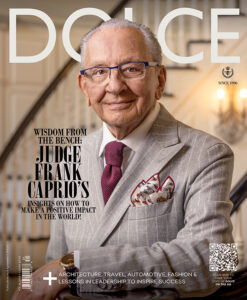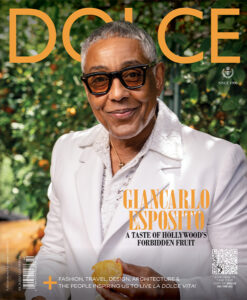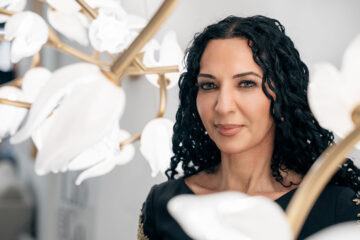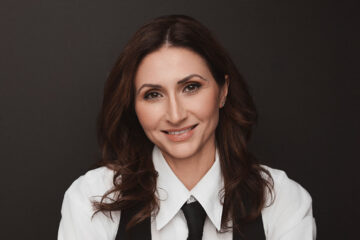Mateo Zielonka: Passion For Pasta
What screams la dolce vita more than indulging in a beautiful plate of pasta?
“I think food is like art; there’s a very fine line in between,” says Mateo Zielonka, a.k.a. the pasta man, known on social media for creating intricate, mesmerizing and colourful pasta creations like Gucci-style ravioli or Banksy-inspired taglierini.
Zielonka’s passion for pasta all started when he was gifted The Sopranos Family Cookbook by his brother at 16 years old. Since then, his fascination for the series ignited something in him, perhaps it was the big Italian-style dinners and generous portions of pasta being served. “It’s kind of interesting because The Sopranos is about the mafia, but actually, there’s a lot about food, about eating together and about going to Vesuvio.”
It was only until years later, when Zielonka left his home in Poland to visit his friend in London, where his culinary journey began. From washing dishes to working in the kitchen, he eventually worked at a fresh pasta restaurant, called Padella, that he learned the foundational techniques of pasta-making.
Today, Zielonka is head chef at 180 The Strand, a collaborative exhibition, events and office space in central London. Dolce sat down with “the pasta man” to learn more about his pasta-making obsession and key to living la dolce vita.
Q: Can you speak on some of the basics of pasta-making?
A: I think it’s very easy, very simple and basic. Either you use semolina flour and water, or egg and 00 flour. The method is the same to make the dough. Knead for 10 minutes, and that’s it. It all depends on what pasta you’d like to make. If you’d like to make egg pasta, you can either use a rolling pin or a pasta machine. It’s so good for your mental health, and it’s so good to share pasta-making with your children and grandchildren.
Q: Can you speak more on the mental health aspect of making pasta and why you believe it’s so therapeutic?
A: I think there are a few things which are good for your mental health, from a kitchen point of view. Let’s say making bread or pasta, you are totally on it. You make the dough, you mix ingredients, you make your hands dirty, and then you feel how the consistency of the dough is changing. It’s just you and the dough. It’s very hard to think of something else, about your problems. It’s a very relaxing process.
Q: What are some of your favourite designs you’ve created thus far?
A: I love a bit of a challenge. Last year, I made pasta for Burberry. They approached me, and we did Burberry icon-striped pasta. Making pasta like that for a shoot was amazing. Two days ago, I made some Gucci pasta, pushing the boundaries a bit. I like to say the sky is the limit. I made Banks pasta, the lady with the balloon. I think food is like art; there’s a very fine line in between.
Q: Where do you source your ingredients from, and how important is it to you to have quality ingredients?
A: I truly believe that less is more. Having good quality produce, you need to use less in the end. It’s like buying a kilo of average cheese and you buying 200 g of very good quality cheese; you need less because it’s so flavourful. I try to buy produce from local suppliers as much as possible. The only thing which I source from abroad is flour. It is Italian flour, Molino Pasini.
Q: How do you achieve the colours in your creations?
A: If you have leftover beetroot, spinach or peppers, you can blend them and add them to egg or water, and you can make the dough with them so you can use leftover vegetables or dehydrated vegetables. I truly believe in using only natural ingredients. You can use whatever you like actually. You can use cocoa powder, as well, to make brown dough … I started experimenting with colourful pasta, which some people like and some people don’t. If someone is going to stop for five seconds to look at my content, and say, “Wow, that pasta looks cool,” that’s already mission complete. I want to encourage people to cook at home a little bit more and eat good food.
Q: In your opinion, what is the biggest difference between American pasta and European pasta?
A: The portion size … just joking! I think you have so many talented people in Canada and the U.S. It’s massive because there’s such a big influence from American-Italian culture. It’s been a dream of mine to go and check how things are done there because there are plenty of good places.
Q: Can pasta fix everything?
A: For sure, pasta makes me happy. I can eat pasta five days a week, I love it. You can make pasta sauce in 10-15 minutes and have a meal made from scratch. You don’t need to make your own pasta sometimes when you’re busy; you can use dry pasta, but you can make your own sauce, for example. I think it definitely makes you happy and makes you feel a bit like being on a holiday if you make a good sauce!
Q: What would your biggest tips be for basic pasta-making?
A: My neighbour brought me fresh tomatoes yesterday from his greenhouse, and what I did was sauté some garlic, chopped the tomatoes and some greens, and I just cooked this down for seven minutes and the pasta was ready. Simplicity. If you have a busy day, and you want to eat something delicious and a bit creamier, just make vodka sauce. It takes 15 minutes, and tastes so delicious!
Q: The interesting thing about pasta is that it’s so versatile, right?
A: The beautiful thing about pasta is that you can make it gluten-free at home, you can make it vegan, with egg, there are so many possibilities. I think in the years to come, we need to push a little bit more. For example, how can we substitute Italian sausage as a vegan dish? And you can do that. It’s all about using spices and different vegetables. But things are going in a very good direction. I think it’s very exciting!
Q: If you were pasta, which one would you be?
A: That’s a good one! I could be two! Culurgiones, which is like a dumpling, and I would swim in tomato sauce, for sure. Or I would be taglierini in pesto. I think simplicity is key. Simple is best.
Q: Where do you feel you are most inspired?
A: There are plenty of places: art galleries, museums, going for a walk in the woods, in the countryside, foraging, meeting people who are foragers and trying new things, trying new foods in restaurants, for sure, gives you an idea of how to create new flavour or a new pasta dish. Also, social media.
Q: Do you eat pasta every day?
A: Five to six times a week.
Q: What is your life motto?
A: I think simplicity. Going back to basics. People are trying to overcomplicate a lot of things in life, and I’m just thinking, “Be happy.” I have lots of tattoos from Pixar, and I just think that a lot of the cartoons teach you something amazing about life and what is important: family, simplicity, friends and not hustle.
Q: What’s next for you?
A: Lots of exciting things are coming up next year. I am thinking of trying to create a food platform for creatives from around the world.
Q: What does la dolce vita, the sweet life, mean to you?
A: It’s kind of interesting. I always romanticize about Italy and their style of living. Work is very important in life, but what’s really important is spending time with friends, eating good food, drinking good wine, because we only have one life!
ONE-SIDE-ONLY STRIPES
200g/7oz classic or rich egg dough
200g/7oz any coloured egg dough
1. Cut roughly one quarter from your disc of classic or rich egg dough, then flatten it a little and guide it twice through the widest setting on your pasta machine (0 on mine). Move to the next widest setting, then take the dough through twice. Fold the dough in half from end to end, flatten it slightly and roll through the machine twice again on the widest setting, then guide the dough twice through each subsequent setting. For filled pasta such as ravioli, tortellini or cappelletti, you want a fine, pliable dough, so stop rolling on setting 8.
2. Lay out the pasta on a work surface or table. Cover with a damp dish towel or clingfilm (plastic wrap). Repeat the above process with a quarter of the coloured dough.
3. Lay the coloured sheet flat on the table and, using a sharp knife, cut strips of around 1cm/ ½ in wide across the width of the dough. I use a metal ruler to keep the strips straight. Now arrange the coloured strips across the width of the egg dough sheet, laying them 1cm/½ in apart for nice, even stripes, or play around with alternate thick or thin stripes, diagonals or checkerboard patterns. Some of the coloured strips may overhang the edges of the sheet of egg dough, so trim to tidy up.
4. Using a rolling pin, roll gently over the whole sheet to connect the coloured stripes to the egg dough sheet beneath.
5. Finally, guide the dough through the pasta machine again on setting 8. This will give you the finished, striped sheet of dough.





























































































